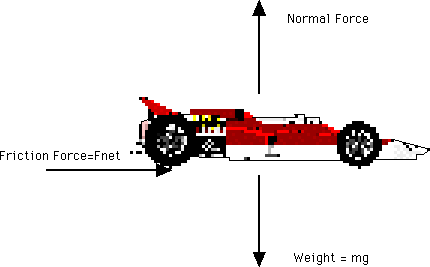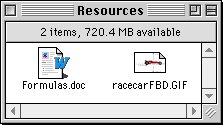| Problem: |
| Buying your first car? Are you sure you're fully prepared to handle all the information that's about to be thrown at you by the car salesman? Well, here's a tip: Don't believe a salesman that promises that your new car has an acceleration any greater than 10m/s2 , no matter the engine size. Why, you ask? Let's find out! |
|

Solution:

| STEP 1: The movement of a car (unlike a jet, for example) depends primarily on the friction force created between the moving tires and the concrete. The tires rotate clockwise and therefore push the concrete backwards (to the left). Friction force opposes motion and pushes forward (to the right). As we all know, the concrete refuses to move, and so the car does instead. |

Normal Force
equals weight.
|

|
| STEP 2: Since the weight and normal force are balanced, the net (total) force is equal to the friction force alone. We can use an established relationship for net force, mass, and acceleration to arrive at the conclusion that the friction force is equal to the product of the mass and acceleration: |

|
| STEP 3: In the question, it was stated that the acceleration of any car could be no greater than 10m/s2 . So, let's say that the acceleration was equal to 10m/s2 . |

|
|
STEP 4: We will use the established relationships for weight and normal force:
|

|
|
STEP 4: We will use the established relationships for weight and normal force:
|

|

|
|
STEP 5: Next, we will use Mu, the coefficient of friction. Mu is a constant, and establishes a relationship between normal force and friction. In simple terms, Mu is the roughness of a surface.
|
| STEP 6: The Mu of rubber on concrete is generally between 0.8 and 1.0, but almost never more than 1.0. Even in general, Mus are rarely above 1.0. If the acceleration were any higher than 10m/s2 (regardless of the mass of car, which cancelled out in STEP 5), the friction force would be required to increase, and therefore Mu would need to increase, which is not possible in real life. Thus, the acceleration of a car of any mass can be no greater than 10m/s2 . |

One is a generally high coeffecient of friction.
|

|
|
Text versions of the equation work are made with Microsoft Equation Editor and are embedded in Microsoft Word documents.
|
|
Movies are saved in QuickTime format available at Apple's site. Get Quicktime 4 today!
|
 |
|
|
|



